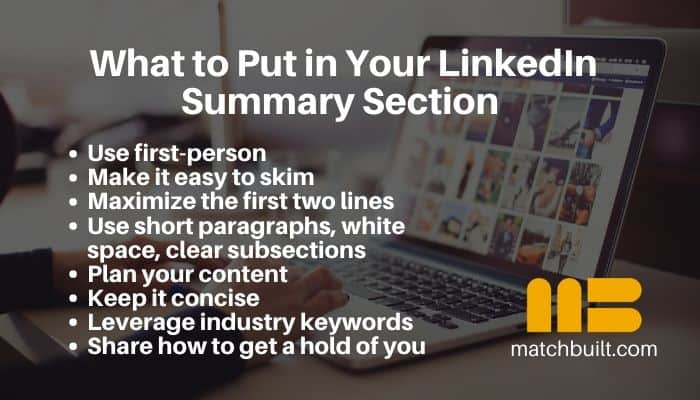It’s essential to revisit your LinkedIn summary section routinely to ensure it provides you with a crisp and professional online presence. Effective LinkedIn summaries should be brief, informative, and engaging. Think of the summary as your elevator pitch. You must be as descriptive as possible in the shortest amount of time.
Here we’ll explore why using first-person is crucial, making the summary section easy to skim and maximizing the first two lines. We’ll discuss leveraging advice from hiring and human resources experts, why the content should be well thought out and concise, leverage industry keywords, and make sure contacts know how to get a hold of you.
So we invite you to read on and learn more, whether you’re improving the LinkedIn summary as a project manager, sales professional, student, career change, customer service, or executive-level role.
How to Write a LinkedIn Summary That Gets Noticed
Over 690 million professionals, millions of active users, and thousands of professionals from tech and biotech to residential construction to the building materials industry are on LinkedIn. It’s a great tool that provides you with many opportunities to network, find jobs, meet potential clients, and drive business.
We’ve read thousands of LinkedIn summaries over the years; some pop and allow for a great introduction.
As a LinkedIn member, you may want to double-check your summary section to make sure it provides you with a crisp and professional online presence. Below are a few ideas to help you improve your LinkedIn summary section for a more effective personal introduction.
Keep in mind that maintaining an effective summary section is just one step in the process of creating a full LinkedIn profile that is very effective. After mastering your summary, you may also review these tips for creating a great LinkedIn headline.
Your LinkedIn Summary Content Should Be Well Thought Out, Concise
1. Introduce Yourself
Have a stand-out introductory sentence that encapsulates who you are.
Perhaps, who are you when you’re not working? What problems do you solve on the job? Do you associate yourself with your educational degree? Do you feel that your profession or industry is part of who you are? We all identify primarily with something specific in our lives, perhaps a defining moment. Are you the sum of several interests?
Your first few sentences are a huge opportunity to summarize yourself.
2. Talk About Your Current Position and Accomplishments
Your current position is a high priority; most viewers will look for it before proceeding further.
Do more than state the job title and describe the problems you solve and a handful of proud leadership achievements. Explain the different roles you do to perform your daily tasks and how you fit in your company.
Remember that it’s also important to share your accomplishments with the data to back them up. A construction project manager, for example, can briefly mention the number of homes they oversee, customer quality results, and build-time achievements. Similarly, a recent grad may want to point out they made the Dean’s List for several years in college.
A good intro lineis one of the most overlooked keys to getting noticed on LinkedIn. A responsible business owner, hiring manager, or recruiter doesn’t just look at the listed experience.To reel them in, I recommend this formula: action word + job title keyword + years of experience + field. For instance, I might put “Industry-leading CEO with 20+ years of experience in the project management field.”But that’s not all. Don’t forget to include what you do. It’s as simple as this: “I excel in helping companies do this.” For instance, I would put “I excel in guiding more than 58,000 project managers through skill-enhancing certifications and courses.”Put together, it should read as the following: Action word + Job title keyword + years of experience + field. What you do.
3. Talk About Your Previous Positions
Today, where you are in your career is the result of all your progressive career advancements and changes. Every time you changed your job, you left with valuable experiences and new goals. Give a brief account of your journey and what you learned.
Discussing your previous roles and responsibilities, and leveraging these other tips for LinkedIn when you are between jobs, helps the reader understand where you’re coming from and where you’re headed.
4. Describe Your Discipline in Your Industry
Describing your field is where you use the shop talk and a few buzz words unique to your industry.
Establish your specialization by mentioning a few keywords, insights, or impressive figures. If you’re new to this field, try to be a well-informed candidate. Try to gather as much information as possible about this profession and show what you know.
5. Be Personable
Try to be approachable and ‘human’ to your network. Share some detail about yourself that’ll make them bond with you. It doesn’t have to be a bright and sunny fact, just a genuine part of you.
Personal details could be anything you care about, so if you’re uncomfortable sharing information about your life, perhaps you can share a quote you like.
6. Mention if Your Team is Currently Hiring
No better opportunity to leverage potential new connections who may be looking for a job.
Let it be known if you’re hiring or if a team member is hiring. You’ll find that your network quickly grows when you’re promoting openings.
7. Give Your Potential Connections a Reason to Be Interested
What can you offer your connections, or how can you add value should contacts choose to network with you? Perhaps you have completed a special skill or recent project from which a potential connection can learn.
Make sure to briefly share your specialty or achievements and let people know you’re open to sharing what went right and wrong along the way.
Don’t Be Afraid to Use the First-Person
Talking in the first person is like telling a story, which always engages readers. While Linkedin is for business professionals, it’s ok to be relaxed and informal as part of your introduction. Some professionals opt for using the third person because it’s the way they routinely write a bio for speaking events or articles.
However, using the first person makes promoting your aspirations and accomplishments easier and more suitable when you mention personal details.
Make It Easy To Skim With Short Paragraphs, White Space, and Clear Subsections
Make your summary easy to skim because no one reads anything anymore. Short paragraphs, white space, and clear subsections make the summary easier to skim. Do not use long-winded paragraphs explaining every detail about your career or recent project manager achievement.
Jacqueline Fisch, an author, copywriter, and business writing coach that is changing how people feel about writing, suggested the following.
People will skim a LinkedIn summary and the about section in 3 seconds, so if it sounds like a robot, they’re out. Your summary should sound human, like all the writing you do.
You’ll also have to do this using plain text (unless this changes in the future). Here are some ways to format this section to help with readability:
Use emojis or a plain dash with spaces for bullets
Use CAPS for subheadings
Use emojis to streamline your contact information
The First Two Lines Are Valuable Real Estate
These lines are what the reader sees first before they have to click the “show more” button, so make them count. You can talk about your current role, leadership abilities, and a critical problem you solve and make it pop, so click for more.
Nick Jordan, the founder & CEO of Workello, a company that helps content teams hire better, added the following.
There’s a reason why the opening 300 words of your essay should be strong. It’s the text that appears on LinkedIn before users are prompted to “see more” and see the remainder of your summary.
As a result, choosing an engaging start that “hooks” your readers and makes them want to study more about you is beneficial. Be sincere and personable in your communication.
Consider beginning with an anecdote, sharing your enthusiasm, describing a noteworthy accomplishment, or speaking directly to the audience. Avoid starting your sentence with a question or using meaningless buzzwords.
Edward Mellet, a Director at WikiJob, a website job seekers use to share information about finance careers and companies, added.
Be Bold
Beginning with a bang is, in my opinion, one of the best methods to compose an effective LinkedIn summary. To get visitors to click “See More,” consider beginning your synopsis with a provocative hook.
If you don’t, make sure to include the most important information about your experience and qualifications at the top of your LinkedIn summary.
What distinguishes you from the rest of the population?
What skill sets of yours are most effective?
What is it about the job that you enjoy so much?
What are some of your most notable achievements?
Using the answers to these questions, you’ll be able to craft a powerful first line of dialogue.
Include Relevant Keywords to Your Industry
Utilizing keywords is another LinkedIn strategy you should leverage but probably aren’t.
Hannah from Career Sherpa suggests that at “the end of your summary, (you) include a list of keywords. The keyword list is the perfect opportunity to interject work processes, skills, and technology you want to get in there without worrying about using them in context. Introduce the list with ‘Key Skills’ or ‘Expertise.'”
Keyword examples and topics in residential construction might include: “high-performing new home sales professional,” “improved cycle time to 110 days”, “routinely red-line blueprints and perform lumber takeoffs,” or “home building customer service professional that knocks out warranty items in less than ten days after closing.”
By crafting a well-written summary, you will improve your chances of being noticed by hiring managers and recruiters.
Michelle Humphrey, the founder and CEO at Resignation Letter Samples, added the following when asked by MatchBuilt:
One key component of an effective LinkedIn profile is a strong summary. This is your opportunity to briefly introduce yourself and highlight your most relevant skills and experience. When writing your summary, be sure to use keywords that hiring managers and recruiters will be searching for.
For example, if you are a marketing professional, you might include keywords such as “branding”, “strategy”, and “social media”. In addition, avoid using generic terms and phrases such as “hard worker” or “team player”. Instead, focus on specific examples of your accomplishments. For instance, you might mention a successful campaign you spearheaded or an award you received for your work.
Make Your Intent Clear
Are you looking to network? Do you want a new career opportunity you’re looking to share? Are you in land acquisition and seeking more master-planned opportunities? Are you a sales manager always seeking top talent? Or an employer recruiting remarkable talent? Let the viewers know what you’re after, and make your intent clear. For example, if you’re explicitly interested in residential construction jobs, clearly state that.
Nelson Sherwin, a Manager at PEO Companies, a professional employer organization that provides mostly HR and regulatory compliance services to businesses, added the following when asked by MatchBuilt.
As an HR manager for an eCommerce company that helps businesses find PEO solutions, I’ve got a pretty good idea of what I’m looking for in a LinkedIn summary.
For me, the thing that catches my attention is a LinkedIn summary that shows me how the person will benefit our business. A long list of accomplishments, awards, etc., are all fine and good, but a summary that says “this is who I am and this is what I can do for you” is one that will get my attention.
I don’t want to have to sort through a bunch of information and have to try to figure out what a person has to offer. I want a summary that tells me what I will get if I hire someone, and then evidence to back up that claim.
For example, “When you hire me, I will bring increased efficiency to your HR department, here’s why…” A statement like that tells me exactly what I’ll get from that person.
Let Your Contacts Know How to Contact You
Include your preferred means of communication in the summary section. Your preferred communication means could be your primary email, phone number, or even Facebook Messenger. It is important to ensure you check it often and regularly.
LinkedIn Summary Examples for Job Seekers
Below are powerful LinkedIn summary examples for job seekers that are looking for a new position as a project manager, construction manager, sales professional, or customer service representative.
We’ve also added examples for students, recent graduates, and those seeking a career change. Remember the tips above about writing a great LinkedIn summary section and making changes necessary to fit your background and career interests.
LinkedIn Summary Example for Project Manager
I specialize in real estate construction, from foundation to client sign-off. I’m proud to have amassed over 10 years of experience in project management for a general contractor, and I’m passionate about translating project visions and objectives into reality, offering tangible results in line with client expectations.
My recent successes include:
- Executed and delivered 55 new homes with a customer service rating of over 90% last year.
- Generated $100k in cost savings by sourcing new construction materials for this division in a very challenging environment.
I’m adept with multiple project management scheduling programs, including BuildPro, and my expertise extends to budget management, stakeholder management, and finance management.
Specialties: Project management, construction, real estate project management, budget management, project delivery, stakeholder management, Agile, Waterfall.
LinkedIn Summary Example for Sales Professional
10+ years experience as an evangelist, strategist, and teacher. Helping prospects and customers make strategic decisions that have a meaningful impact on their supply chain.
Leading great sales teams as small as 5 and as large as 200. Successfully manages P&Ls, and drives attainment hitting revenue goals as high as $300M. Empowering good salespeople to become great salespeople while leveraging traditional and non-traditional methodologies. Soon to be the author of a sales manager’s handbook.
Specialties: Supply Chain, Logistics, Warehousing, eCommerce, PIM, WMS, TMS, B2B, Outsourcing
LinkedIn Summary Example for Students and Recent Graduates
I am an aspiring data scientist who enjoys connecting the dots: be it ideas from different disciplines, people from different teams, or applications from different industries. I have strong technical skills and an academic background in engineering, statistics, and machine learning.
My passion lies in solving business problems with tailored data and algorithms and communicating complex ideas to non-technical stakeholders. I can jump across verticals to deliver high-performing AI solutions.
I’ve taken on various leadership roles in my graduate studies, including mentoring three undergraduate interns, coordinating institute-wide research events for hundreds of people, and leading two journal clubs.
I’m graduating in May 2024 and am interested in full-time data science or machine learning roles. Please feel free to get in touch with me via email at [email protected].
Proficient: Python (scikit-learn, NumPy, SciPy, pandas), TensorFlow, Excel
LinkedIn Summary Example for Career Change
I’ve been working in Project Management for 8 years now, and it’s how I developed my love for all things Sales. I am currently transitioning into Sales by taking a part-time Post Grad course in International Sales and Marketing Management.
While I’ve been successful in my role as Project Coordinator, I find the most rewarding aspects of my work to be in sales and marketing-related areas.
I have a solid foundation in Business Administration and Communication which are invaluable skills, and I plan to implement them in my future positions. I apply the same thinking in Sales that I apply in Project Management because whether you’re connecting with suppliers or communicating with consumers, you need to plan, develop and coordinate relationships.
LinkedIn Summary Examples for Freshers
I have just completed my bachelor’s in marketing from Michigan State University, and due to my solid academic results, my university chose me for the internship at ACME technologies. I have worked there as an internee for 6 months, and I look forward to exploring more opportunities.
I am willing to work with top marketing agencies anywhere in the country, and I believe that marketing is a field that offers diverse ways to attract customers.
I am confident I can enhance my skills by working with any top organization and believe I’d add value specifically to youth engagement in the market.
I would be happy to join as a fresh marketing executive, and I assure you that you will find me to be a hardworking and passionate employee of your company.
LinkedIn Summary Example for Customer Service
A results-oriented and energetic construction manager with an extensive record of broad-based accomplishment in residential construction, customer service, internal performance auditing, training and development, safety management, construction process improvement, risk, and legal exposure mitigation, and financial reporting and forecasting.
I am a process-minded and process-driven leader who creates and manages financially-sustainable operations. Leverages excellent leadership, communication, and customer care skills to develop and support profitable business and customer partnerships. An analytical problem solver with a demonstrated record of success.
LinkedIn Summary Copy and Paste Script Example
The following was shared by the LinkedIn experts at LinkedInRiches.com and provides some very helpful summary ideas.
(Note that I use ALL CAPS for sections like “WHAT I DO” and “WHO I WORK WITH” to help those headers stand out on LinkedIn, which (as of this writing) doesn’t allow you to use bold or italic text on your profile page.)
Here is the script:
WHAT I DO: I help [MY TARGET AUDIENCE] achieve [THEIR TOP GOAL] by providing [MY PRODUCT or SERVICE].
WHO I WORK WITH: I partner with [TARGET AUDIENCE or INDUSTRY TYPE], including:
[INSERT BULLETED LIST OF JOB TITLES, INDUSTRY NAMES, etc.]
WHY IT WORKS: When you partner with [MY COMPANY NAME], you get the most efficient, effective, and affordable [PRODUCT or SERVICE] that [TARGET AUDIENCE] is looking for right now.
WHAT MAKES [ME or the US] DIFFERENT: [Answer that question! What makes you unique/different/better than similar vendors or competitors? XYZ years of experience? Certifications/Patents/etc.? Personal, 1-on-1 attention and Customer Service/Support?]
WHAT OTHERS SAY: [COPY AND PASTE IN 2-3 TESTIMONIALS IN THIS AREA. USE A REAL PERSON, FULL NAME, COMPANY NAME, ETC. AND EXPLAIN THE SPECIFIC VALUE/BENEFIT THE PERSON RECEIVED FROM YOU OR YOUR BUSINESS.]
HOW IT WORKS: [Explain Your process – we start with a free evaluation, first meet via phone to discuss your needs, etc., or perform XYZ services for you, etc.]
READY TO TALK? Reach out to me directly here on LinkedIn, email me at [EMAIL ADDRESS], visit us online at [WEBSITE URL], or call me direct at [PHONE NUMBER].
LinkedIn Summary Section Infographic

Writing a LinkedIn Summary Section Final Tips
Every Fortune 500 company has active users on LinkedIn. If you haven’t lately, it might make sense to revisit your summary section to make sure it provides you with a current and crisp professional online presence.
We believe that LinkedIn is particularly good for construction workers or really any discipline in the industry. Hopefully, these suggestions can offer you an outline to get started. If you subscribed, remember to cancel your LinkedIn Premium plan once you’ve found a new job.



